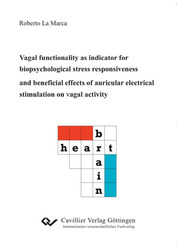| Departments | |
|---|---|
| Book Series (96) |
1378
|
| Nachhaltigkeit |
3
|
| Gesundheitswesen |
1
|
| Humanities |
2363
|
| Medienwissenschaften | 16 |
| Theology | 57 |
| Philosophy | 102 |
| Law | 422 |
| Economics | 850 |
| Social sciences | 416 |
| Sports science | 48 |
| Psychology | 233 |
| Educational science | 190 |
| History | 182 |
| Art | 110 |
| Cultural studies | 166 |
| Literary studies | 116 |
| Linguistics | 88 |
| Natural Sciences |
5406
|
| Engineering |
1791
|
| Common |
98
|
|
Leitlinien Unfallchirurgie
5. Auflage bestellen |
|
Advanced Search
Vagal functionality as indicator for biopsychological stress responsiveness and beneficial effects of auricular electrical stimulation on vagal activity (English shop)
Roberto La Marca (Author)Preview
Table of Contents, Datei (34 KB)
Extract, Datei (57 KB)
The vagus nerve constitutes a major portion of the parasympathetic nervous system. It innervates several vital organs, among others the heart, where it elicits a decrease in HR, therefore minimizing metabolic costs and counterbalancing sympathetic influences. Low vagal activity is associated with several risk factors, morbidity and mortality, while vagal tone can be interpreted as a resource and index of the functional state of an organism. Stress, as a major risk factor, is known to decrease cardiovagal activity, but data are inconsistent, presumably due to methodological problems in association with the high sensitivity of the ANS. On the other hand, interventions increasing vagal activity show beneficial effects on health and well-being. The purpose of the present work was to prove the negative effect of acute stress and the positive effect of auricular stimulation on vagal activity. Additionally, we aimed to examine the role of vagal functionality as a resource during stress.
We therefore conducted two studies. Thirty-three healthy male subjects participated in random order in a psychosocial stress and control condition. Stress was induced by the Montreal Imaging Stress Task (MIST). To examine whether vagal functionality can be interpreted as resource during stress, a functional diagnostic test was further conducted (cold face test, CFT). In the stimulation study, manual and electroacupuncture were applied to the ear in 14 healthy male subjects while controlling for several confounding factors (among others placebo effect). Vagal activity was measured with the LifeShirt System 200 (Vivometrics, CA, USA).
Analyses identified a significant stress-induced decrease in vagal activity and mood, while provoking an increase in sympathetic and HPA axis activity. Vagal functionality was revealed to be inversely related to the biopsychological stress response. In contrast to stress, electric but not manual stimulation to the ear revealed a significant increase in vagal activity.
In the present work, we were able to underline the harmful character of stress on several body systems while boosting the role of vagal functionality for health. Additionally, electrical stimulation to the ear possibly constitutes a simple, mildly invasive method to improve individual health status, adaptability and flexibility.
| ISBN-13 (Printausgabe) | 3869550708 |
| ISBN-13 (Hard Copy) | 9783869550701 |
| ISBN-13 (eBook) | 9783736930704 |
| Final Book Format | A5 |
| Language | English |
| Page Number | 170 |
| Lamination of Cover | glossy |
| Edition | 1 Aufl. |
| Volume | 0 |
| Publication Place | Göttingen |
| Place of Dissertation | Universität Zürich |
| Publication Date | 2009-08-04 |
| General Categorization | Dissertation |
| Departments |
Philosophy
Psychology |








